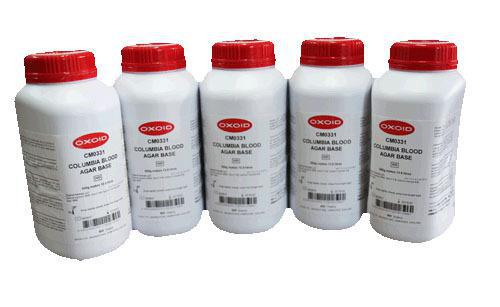Oxoid CM1135K BHI肉汤 BRAIN HEART INFUSION 说明书
BHI脑心浸出液肉汤培养基
英文:Brain Heart Infusion Broth (Dehydrated)
缩写:BHI
规格:500克
货号:CM1135
质检报告:含
是否有货:现货
类型:培养基
BRAIN HEART INFUSION BROTH
Code: CM1135
A highly nutritious infusion medium recommended for the cultivation of streptococci, Neisseria and other fastidious organisms.
| Formula |
gm/litre |
| Brain infusion solids |
12.5 |
| Beef heart infusion solids |
5.0 |
| Proteose peptone |
10.0 |
| Glucose |
2.0 |
| Sodium chloride |
5.0 |
| Disodium phosphate |
2.5 |
| pH 7.4 ± 0.2 @ 25°C |
Directions
Dissolve 37g in 1 litre of distilled water. Mix well and distribute into final containers. Sterilize by autoclaving at 121°C for 15 minutes.
Description
A versatile liquid infusion medium which is suitable for the cultivation of streptococci, Neisseria and other fastidious organisms, this medium is recommended for blood culture work and, with the additions described below, for the isolation and cultivation of pathogenic fungi.
Oxoid Brain Heart Infusion Broth is essentially a buffered infusion broth, giving similar results to the brain dextrose broths originally employed for the cultivation of streptococci1, and for the cultivation of dental pathogens2. The addition of 0.1% agar will serve to reduce convection currents and so create conditions of varying oxygen tension which favour the growth and primary isolation of aerobes and anaerobes3, while even easily cultivated organisms show improved growth4.
Oxoid Brain Heart Infusion Broth was used in a test for the pathogenicity of streptococci5,6 and the same medium was enriched with ascitic fluid for the cultivation of gonococci7. It is especially useful as a growth and suspension medium for staphylococci which are to be tested for coagulase production; Newman8 employed a similar medium for this purpose in an investigation of food poisoning caused by dairy products.
A satisfactory medium for blood culture can be prepared by adding 1g of agar per litre of Brain Heart Infusion Broth. Ensure that the agar is uniformly distributed in the sterile broth before dispensing into bottles.
Tubes of Oxoid Brain Heart Infusion Broth which are not used the same day as sterilized should be placed in a boiling water bath for several minutes to remove absorbed oxygen, and cooled rapidly without shaking, just before use.
Further supplements to improve the recovery of organisms from blood can be added before sterilization or aseptically post-sterilization. Co-enzyme1 (NAD), penicillinase and p-amino benzoic acid are examples. Brain Heart Infusion Broth supplemented with yeast extract, haemin and menadione was consistently better in producing heavy growth of five species of Bacteroides than three standard anaerobic broths. Furthermore, microscopy of overnight cultures showed normal morphology in Brain Heart Infusion Broth but abnormal morphology in the three anaerobic broths9.
Storage conditions and Shelf life
Store the dehydrated medium at 10-30°C and use before the expiry date on the label.
Store tubed or bottled medium in the dark and below 20°C.
Appearance
Dehydrated medium: Straw coloured, free-flowing powder.
Prepared medium: Straw coloured solution.
Quality control
| Positive controls | Expected results |
| Streptococcus pneumoniae ATCC® 6303* | Turbid growth |
| Candida albicans ATCC® 10231* | Turbid growth |
| Negative control | |
| Uninoculated medium | No change |
*This organism is available as a Culti-Loop®
References
1. Rosenow E. C. (1919) J. Dental Research l. 205-249.
2. Haden R. L. (1923) Arch. Internal Med. 32. 828-849.
3. Hitchens A. P. (1921) J. Infectious Diseases 29. 390-407.
4. Falk C. R. et al. (1939) J. Bact. 37. 121-131.
5. Chapman G. H. et al. (1944) Am. J. Clin. Path. 9: Tech. Suppl. 3. 20-26.
6. Chapman G. H. (1946) Am. J. Digestive Diseases 13. 105-107.
7. Reitzel R. J. and Kohl C. (1938) J. Am. Med. Assoc. 110. 1095-1098.
8. Newman R. W. (1950) J. Milk and Food Tech. 13. 226-233.
9. Eley A., Greenwood D. and O’Grady F

